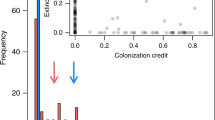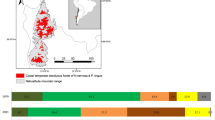Abstract
Changes in species richness along the ecological succession gradient may be strongly determined by coexisting extinction debts of species from the original habitats and colonization credits of those from the replacing habitats. The magnitude of these processes and their causes remain largely unknown. We explored the extinction debt and colonization credit for grassland and forest specialist plants, respectively, and the local and landscape factors associated to the richness of these species groups in a 50-year process of forest encroachment into semi-natural Mediterranean grasslands. A set of sampling plots of persistent grasslands and forests and their transitional habitat (wooded grasslands) was selected within fixed-area sites distributed across the landscape. Our results confirm the extinction debt and suggest colonization credit (according to observed trends and model predictions) in wooded grasslands when compared to persistent forests, despite wooded grasslands and persistent forests having similar tree cover. Grassland connectivity and solar radiation had opposing effects on the richness of both grassland and forest specialists, and it is possible that the availability of seed sources from old forests may have accelerate the payment of colonization credit in the wooded grasslands. These results suggest that extinction debt and colonization credit have driven species turnover during the 50 years of forest encroachment, but at different rates, and that local and landscape factors have opposing effects on these two phenomena. They also highlight the importance of documenting biodiversity time lags following habitat change when they are still in progress in order to timely and adequately manage habitats of high conservation value such as the grasslands studied here.



Similar content being viewed by others
References
Adriaens D, Honnay O, Hermy M (2006) No evidence of a plant extinction debt in highly fragmented calcareous grasslands in Belgium. Biol Conserv 133:212–224. doi:10.1016/j.biocon.2006.06.006
Aitchison J (1982) The statistical analysis of compositional data. J R Stat Soc Ser B 44:139–177. doi:10.2307/2345821
Baan L, Alkemade R, Koellner T (2012) Land use impacts on biodiversity in LCA: a global approach. Int J Life Cycle Assess 18:1216–1230. doi:10.1007/s11367-012-0412-0
Bagaria G, Pino J, Rodà F, Guardiola M (2012) Species traits weakly involved in plant responses to landscape properties in Mediterranean grasslands. J Veg Sci 23:432–442. doi:10.1111/j.1654-1103.2011.01363.x
Bartoń K (2014) MuMIn: multi-model inference. R package version 1.10.0. Available at:http://www.cran.r-project.org/package=MuMIn
Başnou C, Vicente P, Espelta JM, Pino J (2015) Of niche differentiation, dispersal ability and historical legacies: what drives woody community assembly in recent Mediterranean forests? Oikos. doi:10.1111/oik.02534
Bolòs O, Vigo J, Masalles RM, Ninot JM (2005) Flora manual dels Països Catalans. Pòrtic, Barcelona
Cornwell WK, Grubb PJ (2003) Regional and local patterns in plant species richness with respect to resource availability. Oikos 100:417–428. doi:10.1034/j.1600-0706.2003.11697.x
Cousins SAO, Vanhoenacker D (2011) Detection of extinction debt depends on scale and specialisation. Biol Conserv 144:782–787. doi:10.1016/j.biocon.2010.11.009
Cristofoli S, Piqueray J, Dufrene M, Bizoux J, Mahy G (2010) Colonization credit in restored wet heathlands. Restor Ecol 18:645–655. doi:10.1111/j.1526-100X.2008.00495.x
Dambrine E, Dupouey J-L, Laüt L, Humbert L, Thinon M, Beaufils T, Richard H (2007) Present forest biodiversity patterns in France related to former Roman agriculture. Ecology 88:1430–1439. doi:10.1890/05-1314
Debussche M, Lepart J, Dervieux A (1999) Mediterranean landscape changes: evidence from old postcards. Glob Ecol Biogeogr 8:3–15
Díaz-Villa MD, Marañón T, Arroyo J, Garrido B (2003) Soil seed bank and floristic diversity in a forest-grassland mosaic in southern Spain. J Veg Sci 14:701–709. doi:10.1111/j.1654-1103.2003.tb02202.x
Eriksson O (1996) Regional dynamics of plants: a review of evidence for remnant, source-sink and metapopulations. Oikos 77:248–258. doi:10.2307/3546063
Eriksson O, Cousins SAO, Bruun HH (2002) Land-use history and fragmentation of traditionally managed grasslands in Scandinavia. J Veg Sci 13:743–748. doi:10.1111/j.1654-1103.2002.tb02102.x
Fahrig L (2003) Effects of habitat fragmentation on biodiversity. Annu Rev Ecol Evol Syst 34:487–515. doi:10.1146/annurev.ecolsys.34.011802.132419
Grime JP (2001) Plant strategies, vegetation processes, and ecosystem properties. Wiley, Chichester
Grove AT, Rackham O (2001) The nature of Mediterranean Europe: An ecological history. Yale University Press, New Haven
Guardiola M, Pino J, Rodà F (2013) Patch history and spatial scale modulate local plant extinction and extinction debt in habitat patches. Divers Distrib 19:825–833. doi:10.1111/ddi.12045
Hanski I (1999) Metapopulation ecology. Oxford University Press, Oxford
Hanski I (2000) Extinction debt and species credit in boreal forests: modelling the consequences of different approaches to biodiversity conservation. Ann Zool Fenn 37:271–280
Helm A, Hanski I, Pärtel M (2006) Slow response of plant species richness to habitat loss and fragmentation. Ecol Lett 9:72–77. doi:10.1111/j.1461-0248.2005.00841.x
Helm A, Zobel M, Moles AT, Szava-Kovats R, Pärtel M (2015) Characteristic and derived diversity: implementing the species pool concept to quantify conservation condition of habitats. Divers Distrib 21:711–721. doi:10.1111/ddi.12285
Hothorn T, Bretz F, Westfall P (2008) Simultaneous inference in general parametric models. Biometric J 50:346–363. doi:10.1002/bimj.200810425
Hylander K, Ehrlén J (2013) The mechanisms causing extinction debts. Trends Ecol Evol 28:341–346. doi:10.1016/j.tree.2013.01.010
Hylander K, Weibull H (2012) Do time-lagged extinctions and colonizations change the interpretation of buffer strip effectiveness?—a study of riparian bryophytes in the first decade after logging. J Appl Ecol 49:1316–1324. doi:10.1111/j.1365-2664.2012.02218.x
Jackson ST, Sax DF (2010) Balancing biodiversity in a changing environment: extinction debt, immigration credit and species turnover. Trends Ecol Evol 25:153–160. doi:10.1016/j.tree.2009.10.001
Jacquemyn H, Butaye J, Hermy M (2003) Influence of environmental and spatial variables on regional distribution of forest plant species in a fragmented and changing landscape. Ecography 26:768–776. doi:10.1111/j.0906-7590.2003.03620.x
Krauss J, Bommarco R, Guardiola M, Heikkinen RK, Helm A, Kuussaari M, Lindborg R, Öckinger E, Pärtel M, Pino J, Pöyry J, Raatikainen KM, Sang A, Stefanescu C, Teder T, Zobel M, Steffan-Dewenter I (2010) Habitat fragmentation causes immediate and time-delayed biodiversity loss at different trophic levels. Ecol Lett 13:597–605. doi:10.1111/j.1461-0248.2010.01457.x
Kühn I, Bierman SM, Durka W, Klotz S (2006) Relating geographical variation in pollination types to environmental and spatial factors using novel statistical methods. New Phytol 172:127–139. doi:10.1111/j.1469-8137.2006.01811.x
Kuussaari M, Bommarco R, Heikkinen RK, Helm A, Krauss J, Lindborg R, Öckinger E, Pärtel M, Pino J, Rodà F, Stefanescu C, Teder T, Zobel M, Steffan-Dewenter I (2009) Extinction debt: a challenge for biodiversity conservation. Trends Ecol Evol 24:564–571. doi:10.1016/j.tree.2009.04.011
Lindborg R, Helm A, Bommarco R, Heikkinen RK, Kühn I, Pykälä J, Pärtel M (2012) Effect of habitat area and isolation on plant trait distribution in European forests and grasslands. Ecography 35:356–363. doi:10.1111/j.1600-0587.2011.07286.x
Lira PK, Ewers RM, Banks-Leite C, Pardini R, Metzger JP (2012) Evaluating the legacy of landscape history: extinction debt and species credit in bird and small mammal assemblages in the Brazilian Atlantic Forest. J Appl Ecol 49:1325–1333. doi:10.1111/j.1365-2664.2012.02214.x
Magee L (1990) R 2 measures based on Wald and likelihood ratio joint significance tests. Am Stat 44:250–253. doi:10.2307/2685352
McIntyre S, Barrett GW (1992) Habitat variegation, an alternative to fragmentation. Conserv Biol 6:146–147. doi:10.1046/j.1523-1739.1992.610146.x
Öckinger E, Eriksson AK, Smith HG (2006) Effects of grassland abandonment, restoration and management on butterflies and vascular plants. Biol Conserv 133:291–300. doi:10.1016/j.biocon.2006.06.009
Pierik M, van Ruijven J, Bezemer T, Berendse F (2010) Travelling to a former sea floor: colonization of forests by understorey plant species on land recently reclaimed from the sea. J Veg Sci 21:167–176. doi:10.1111/j.1654-1103.2009.01134.x
Pinheiro J, Bates D, DebRoy S, Sarkar D, R Core Team (2014) nlme: Linear and nonlinear mixed effects models. R package version 3.1-117. Available at: http://www.cran.r-project.org/package=nlme
Piqueray J, Cristofoli S, Palm R, Bisteau E, Mahy G (2011) Testing coexistence of extinction debt and colonization credit in fragmented calcareous grasslands with complex historical dynamics. Landsc Ecol 26:823–836. doi:10.1007/s10980-011-9611-5
Piqueray J, Saad L, Bizoux J-P, Mahy G (2013) Why some species cannot colonise restored habitats? The effects of seed and microsite availability. J Nat Conserv 21:189–197. doi:10.1016/j.jnc.2012.12.005
R Development Core Team (2014) R: a language and environment for statistical computing. R package version 3.1.0. Available at: http://www.r-project.org
Rivas-Martínez S, Fernández-González F, Loidi J, Lousa M, Penas A (2001) Syntaxonomical checklist of vascular plant communities of Spain and Portugal to association level. Itinera Geobot 14:5–341
Sax DF, Brown JH (2000) The paradox of invasion. Glob Ecol Biogeogr 9:363–371. doi:10.1007/s00442-011-2203-x
Therneau T, Atkinson B, Ripley B (2013) rpart: Recursive Partitioning. R package version 4.1-1. Available at: http://www.cran.r-project.org/package=rpart
Tilman D, May R, Lehman CL, Nowak MA (1994) Habitat destruction and the extinction debt. Nature 371:65–66. doi:10.1038/371065a0
Vellend M (2003) Habitat loss inhibits recovery of plant diversity as forests regrow. Ecology 84:1158–1164. doi:10.1890/0012-9658(2003)084[1158:HLIROP]2.0.CO;2
Vellend M (2005) Land-use history and plant performance in populations of Trillium grandiflorum. Biol Conserv 124:217–224. doi:10.1016/j.biocon.2005.01.027
Vellend M, Verheyen K, Jacquemyn H, Kolb A, Van Calster H, Peterken G, Hermy M (2006) Extinction debt of forest plants persists for more than a century following habitat fragmentation. Ecology 87:542–548. doi:10.1890/05-1182
Verheyen K, Guntenspergen GR, Biesbrouck B, Hermy M (2003a) An integrated analysis of the effects of past land use on forest herb colonization at the landscape scale. J Ecol 91:731–742. doi:10.1046/j.1365-2745.2003.00807.x
Verheyen K, Honnay O, Motzkin G, Hermy M, Foster DR (2003b) Response of forest plant species to land-use change: a life-history trait-based approach. J Ecol 91:563–577. doi:10.1046/j.1365-2745.2003.00789.x
Weiss RE (2005) Modeling longitudinal data. Springer, New York. doi:10.3109/02813439309045499
Zulka KP, Abensperg-Traun M, Milasowszky N, Bieringer G, Gereben-Krenn B-A, Holzinger W, Hölzler G, Rabitsch W, Reischütz A, Querner P, Sauberer N, Schmitzberger I, Willner W, Wrbka T, Zechmeister H (2014) Species richness in dry grassland patches of eastern Austria: a multi-taxon study on the role of local, landscape and habitat quality variables. Agric Ecosyst Environ 182:25–36. doi:10.1016/j.agee.2013.11.016
Acknowledgments
We thank M. Guardiola for fieldwork and plant identification support, L. Sáez for help with plant identification, G. Esparza for fieldwork assistance, J.M. Ninot for advice on plant specialists’ lists, P. Vicente for digitizing the 1956 orthophotomap and performing the training points for reclassification of the orthophotomaps, M. Pärtel for advice in conducting the analyses and M. Pärtel and two anonymous referees for valuable comments on the manuscript. This study was funded by MICINN (Spain) in the project LANDPOLNET (CGL2009-12646) and by the Spanish Consolider-Ingenio 2010 program in the project MONTES (CSD2008-00040). G. Bagaria was supported by a Pre-doctoral FPU fellowship (AP2009-4599) from the Ministerio de Educación y Ciencia (Spain). A. Helm was supported by the Estonian Research Council (Grant no 9223) and by the EU through the European Regional Development Fund (Centre of Excellence FIBIR). The experiments comply with the current laws of the country (Spain) in which the experiments were performed.
Conflict of interest
The authors declare that they have no conflict of interest.
Author information
Authors and Affiliations
Corresponding author
Additional information
Communicated by Truman Young.
Electronic supplementary material
Below is the link to the electronic supplementary material.
Rights and permissions
About this article
Cite this article
Bagaria, G., Helm, A., Rodà, F. et al. Assessing coexisting plant extinction debt and colonization credit in a grassland–forest change gradient. Oecologia 179, 823–834 (2015). https://doi.org/10.1007/s00442-015-3377-4
Received:
Accepted:
Published:
Issue Date:
DOI: https://doi.org/10.1007/s00442-015-3377-4




